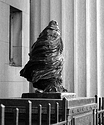Hi, everybody! I found this discussion by chance only. But I think I may contribute with some experiments I made. A few years ago I restarted doing film photography like in the old times. I realized then that there were now alternative processes like Caffenol, Caffenol and vit. C and some other discoveries in what concerns B&W developers. But, for my surprise, nobody was trying to find an alternative to the fixer bath. Then I started investigating on that and I found some alternatives. The first one I found was concentrated Ammonia. It works, it is fast, but may not fix all films and the fumes are terrible. I made that a couple of times at my balcony. Reading more, I realized that before Herschel's proposal of Sodium Thiosulfate, salt was used in a very concentrated solution and warm. So, one night I made the more concentrated solution I could of salt, warm and put a small stripe of film in it, maybe Fomapan 100, I think. After waiting several minutes and nothing happened, I went to sleep. Next day, just for curiosity, I took a look to the stripe and... it was totally clear, as fixed with thiosulfate. I published this result at the Caffenol Group in Flickr and there was a big discussion and resistance. I met Reinhold G. (
http://caffenol.blogspot.de) because he first denied the fact and later published «Errare humanum est», where he agrees with me that salt may fix films.
My first recipe was to use 300 g salt per liter, only and 24 hours at room temperature or less if one uses temperatures above room temperature.
But yes, some films like T grain films resisted for days until they were (bad) fixed with salt.
All this happened in Spring/Summer of 2012!
Meanwhile, the subject has been sleeping and nobody was really interested in it. But now things are changing and I decided to improve this surprising fixer. I discovered 3 things that makes it better:
1. The salt solution should be filtered with coffee filter. This filtering will retain impurities and also small salt crystals that will induce a fast recrystallization that may damage the film producing small holes in it.
2. A few amount of Potassium Bromide (2-4g/l) will also delay salt crystallization for more than 48 hours and speeds the fixing to some hours less but not much.
3. A very small amount of household bleach (Sodium Hypochlorite) will reduce the fixing time to just a few hours at room temperature for common films and about 10 hours for T-Grain films. I have a household bleach that says <5% Sodium Hypochlorite and from it I use 2 ml/liter. So it is really a very small amount. Even so, the solution will turn slightly yellow (what indicates that some Chlor is released).
Another possible alternative, other than salt:
Potassium Metabisulfite and Sulfur are easy to find in farming shops, they are used in wine making. With these two stuffs one may prepare Potassium Thiosulfate, another good alternative fixer.
As Recipe, dissolve 100 g of Potassium Metabisulfite in 1 liter of water, put in a stainless steel kettle and bring it to boil. Add 10 g of Sulfur and let it boil in low fire for several minutes. You will end with about 500 ml of liquid. Filter the unreacted Sulfur with coffee filter and use as fixer. It takes about 2 hours to completely fix. I think that a very small amount of metabisulfite reacts with Sulfur to give Thiosulfate and so the fixer is slow compared with regular fixers of Sodium and Ammonium Thiosulfate.
For more, visit me at
http://caffenolcolor.blogspot.pt








